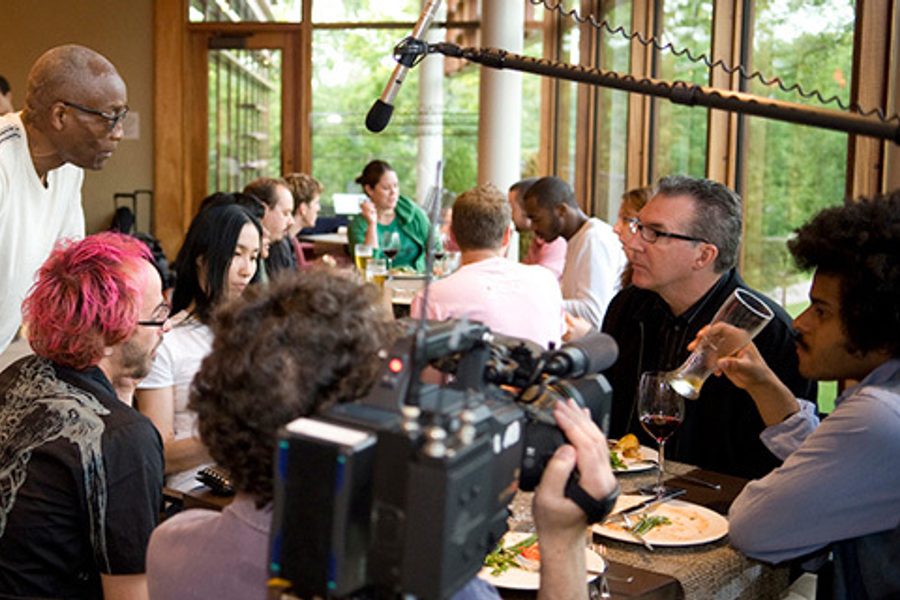In Search of ‘A Good Man’
Veteran filmmaker Gordon Quinn discusses his latest documentary, Bill T. Jones: A Good Man
David Moberg

Bill T. Jones: A Good Man, a documentary co-directed by Gordon Quinn of Chicago-based Kartemquin Films, follows the prominent, politically progressive African-American dancer and choreographer and his collaborators for a year as they create a major theatrical dance piece about Abraham Lincoln. It’s a fascinating inside look into the world of dance and a vibrant portrait of Jones, who is both emotionally and intellectually engaging. The film explores Jones’ ambivalent feelings about Lincoln and his hopes for democracy in America.
It also continues a tradition at Kartemquin, which Quinn co-founded 45 years ago, of investigating the process of all types of work – from artistic (two films about the painter Leon Golub) to manufacturing (The Last Pullman Car), and industrial unionism (Taylor Chain) to athletic (Hoop Dreams, Kartemquin’s most famous film).
On November 11, A Good Man was broadcast on PBS as part of the 25th anniversary season of the American Masters series (you can watch the film here). It is also available as a DVD directly from Kartemquin.
Quinn recently discussed his latest project with In These Times.
David Moberg: What led you to take on this project about A Good Man?
Gordon Quinn: It was unusual, but not that unusual, because some of our projects, like The Last Pullman Car, grew out of a group of workers approaching us about their story. In this case, Ravinia Festival had commissioned Bill T. Jones to do a major piece on Abraham Lincoln for the bicentennial. As soon as I heard about it, I thought, Bill T. Jones, Abraham Lincoln – this has got to be good. And it was right at the beginning. We filmed the press conference when it was announced. We were there right at the beginning so that we could really follow the process of a major American artist creating this huge dance/theater work and struggling with all of his feelings about Lincoln. That’s what we’re really interested in, the process of creating work like that.
DM: Did you discover anything different in this particular creative process?
GQ: I knew that he worked with his dancers very collaboratively, and I knew that we would get that process of collaboration, fraught with tensions and subtexts. I hoped there would be tensions within him regarding his feelings about Lincoln, and that certainly came out in the film.
DM: It was striking how thoughtful he was about the process. You don’t expect dancers to be historians.
GQ: He’s an intellectual, and I love that moment in the film – we put it in there quite purposely – when he says, I just want to be able to engage in the intellectual, the civic life of our country. He doesn’t want to be put in some box as an artist where you’re not supposed to deal with anything. With dance, that’s often what people do. In a sense, what makes him controversial is he cares passionately about the world he lives in, and he’s not just making beautiful things, he’s dealing with the world, as other dancers have, confronting contradictions, burrowing deeper and being very emotional, all of which attracted us to him.
I think it’s very interesting to see his arc. When we first started making the movie, I thought, here was a guy who has done major works on mortality and our country’s fundamental contradiction around race and slavery. I figured this was going to be his piece about democracy ultimately, because he’s dealing with Abraham Lincoln. For a long time, that doesn’t emerge from what he’s dealing with, and I sort of forgot about it. Then near the end, his belief in democracy comes to the fore, and I think it helps explain how the film ended up. That’s a little bit surprising, because I’d forgotten about it, to see how he worked his way through all this material.
DM: It seems like an easy collaboration for you to do. Were there any difficulties?
GQ: No, if you’re dealing with an artist, and they’ve bought into it, it’s easier than some situations where we’ve done films. On the other hand, he didn’t know us. The press has burned him on various occasions. I think he did say on one panel that once he understood our politics, that we were progressive, left, he was more comfortable. But there were moments when he was nervous. We would interview dancers at home, and he asked, “What were they saying about me?”
There were moments when he was very intense. Making art is not easy, and it takes a lot out of people, and for me it always comes out of some dialectical relationship. Some of the struggles he gets into with his collaborators are not always pretty, but something emerges from that, even if afterward he thought he could have handled it in a better fashion.
DM: How much time did you spend shooting this film?
GQ: We spent about a year – it took him that long to create the piece. … We couldn’t be there for everything, but we were following certain things and had our contacts within the company who would say, “We’re working on this now,” and it was something we’d seen in earlier forms, so we’d want to be sure to get that.
Many years ago we did a film about Leon Golub, and we were constantly running out of money. He worked on several paintings at once, and we were following creation of this one painting – I love this idea of process and seeing how art gets made – and we would say, “Leon, we can’t come right now. Can you work on another painting?” And he would say, “Oh, sure,” and work on another painting for a month. [With Bill Jones], there was no such arrangement. They had to get this done. We had to figure it out for ourselves.
DM: I found the excerpts of the dance particularly intriguing. It made me regret not seeing the entire performance. How did you decide how much to include in the film?
GQ: That’s an important question. It’s a sign of success that you watched the movie and at the end wanted to see the dance. We knew from the beginning… [Co-director Bob Hercules] and I said we don’t want to film the performance. If you want to see the performance, you need to go see the performance. We wanted to show how it was made. We used bits and pieces of the complete performance, and we did film the first performance with six or seven cameras. But we wanted people coming away saying, I wish I could experience it. We were very careful about how much we show you.
DM: How did critics and others receive the dance? You interview people from the audience with mixed reactions.
GQ: It’s a hallmark of our films about art that there are no critics in them. The response here in Chicago was very mixed. As Bill says, “If this were a Broadway play, this would be our test run.” As the performance toured the country, they changed a lot of things. The performance now is different from its premiere, and the reviews got progressively better as they kept changing it. I saw it in New York – from a seat, much different from being behind a camera – and I was knocked out. I liked it the way it was originally, but clearly it was working better for audiences and critics once they honed it.
DM: Is there something more that you think people should know about the film?
GQ: I read all about Bill T. Jones, … about this big controversy when the critic Arlene Croce wrote about Still/Here, [Jones’ 1994 production] about people dying of AIDS. And she wrote this critique but said she wasn’t going to see it, because he’d made himself “bullet-proof” by the politics with which he surrounded the piece: people are dying…he’s African- American. I remember reading it at the time and feeling she was not just attacking him but attacking everyone who feels that art should be engaged with the real world and what’s happening to people. To say that she’s not going to see it because it’s immune to criticism, that infuriated me at the time.
Bill is also controversial in the dance world because he brings so many elements together. I thought that was important for the film, but every time I tried to talk to him about that, he just didn’t want to go there. He’d blow it off. He didn’t want to talk about the controversies.
After a while, I realized he was right. This is not what this film wants to be about. It would distort the film into something about the past. At first I wanted to get him to talk about this, but I realized it wasn’t relevant to what we’re seeing: the drama of this work being created and where he ends up on democracy. …
DM: Do you think you were drawn to him because you saw him as a kindred spirit?
GQ: I thought, Here is a major American artist. And I have in the back of my mind this notion that every 10 or 15 years I’d like to do a film on how art gets made. There’s something reflexive about it. It makes you come to terms with what you’re doing. I think we learned a tremendous amount about who we are and our own process making a film about Leon Golub.
I’m still digesting the experience of working with Bill, who is so dynamic, charismatic and intellectual. He’s at the top of his game now, one of the biggest names in the dance world. That’s very appealing to me, though I know nothing about dance, nothing about the dance world. The company was here in town a couple weeks ago doing some other pieces, and I was totally excited about it. I was someone who couldn’t even social dance. Now I’m someone who wants to go to the dance. I’m into it now.
Editor’s note: Part 2 of this interview, in which Quinn discusses Kartemquin’s history and filmmaking process, can be read here.
David Moberg, a former senior editor of In These Times, was on staff with the magazine from when it began publishing in 1976 until his passing in July 2022. Before joining In These Times, he completed his work for a Ph.D. in anthropology at the University of Chicago and worked for Newsweek. He received fellowships from the John D. and Catherine T. MacArthur Foundation and the Nation Institute for research on the new global economy.








